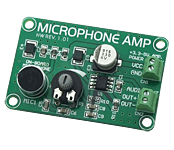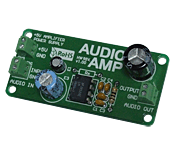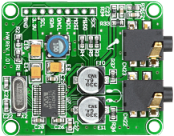 |

|
|
The Microphone AMP Board enables you to add a power amplifier with microphone to your applications. There is an on-board Audio Power Amplifier LM386 and microphone that can be connected to your prototype device via an on-board screw terminal. |
|
|
|
 |

|
|
The AudioAMP Board features an on-board power amplifier LM386 designed for use in low voltage consumer applications. The quiescent power drain is only 24 milliwatts. The board can be connected to your prototype device via on-board screw terminals. |
|
|
|
 |

|
|
SpeakUp 2 click is a speech recognition click board with a simplified design compared ot the original SpeakUp click. Set it up to recognize up to 100 commands and have the onboard MCU carry them out instantly. |
|
|
|
 |

|
|
The SpeakUp click is a speaker dependent speech recognition accessory board, which also has the ability to run standalone (no external microcontroller needed). It can be programmed to recognize over 200 different voice commands, which the onboard STM32F415RG MCU can react to. It works by matching sounds with pre-recorded commands. The firmware is based on the DTW speech recognition alghoritm, which enables fast operation with instant recognition. Sound is received through an onboard microphone and then processed by a VS1053 IC with a built in stereo-audio codec. The SpeakUp comes with a dedicated software tool for easy configuration. The board is lined with 12 user programmable GPIOs for standalone functionality, and can also be connected to a mikroBUS host socket, with communcation via SPI, I2C or UART.
|
|
|
|
 |

|
|
The Audio Codec Board - PROTO is a development tool for the WM8731 Audio Codec, ideal for use in embedded applications which require audio playback. The on-board Audio Codec WM8731 provides stereo line and mono microphone level audio inputs. This module also uses stereo 24-bit multi-bit sigma delta ADCs and DACs with oversampling digital interpolation and decimation filters. Stereo audio outputs are buffered for driving headphones from a programmable volume control. Line level outputs are also provided along with anti-thump mute and power up/down circuitry. The device is controlled via 2 wire (I2C) or 3 wire (SPI) serial interface. |
|
|
|
 |

|
|
Text To Speech click is a mikroBUS add-on board that carries an Epson S1V30120 speech synthesis IC. The IC is powered by the Fonix DECtalk v5 speech synthesis engine that can make your robot or portable device talk in US English, Castilian Spanish or Latin American Spanish, in one of nine pre-defined voices. The DECtalk engine includes a parser that gives users fine control over the quality, pitch and intonation of the synthesized speech. The audio is reproduced at 11.025kHz sampling rate. Text To Speech click board communicates with the target board microcontroller through the mikroBUS SPI interface (MISO, MOSI, SCK, CS) with additional functionality provided by DRDY, NRST and MUTE pins (in place of default mikroBUS INT, RST and AN pins) It can use either a 3.3V or 5V power supply. |
|
|
|
 |

|
|
BT Audio click features Microchip's RN52 Bluetooth audio module. With onboard 3.5mm jacks for both a microphone and a speaker, this is a complete solution for streaming audio from a smartphone or PC over a wireless connection. |
|
|
|
 |

